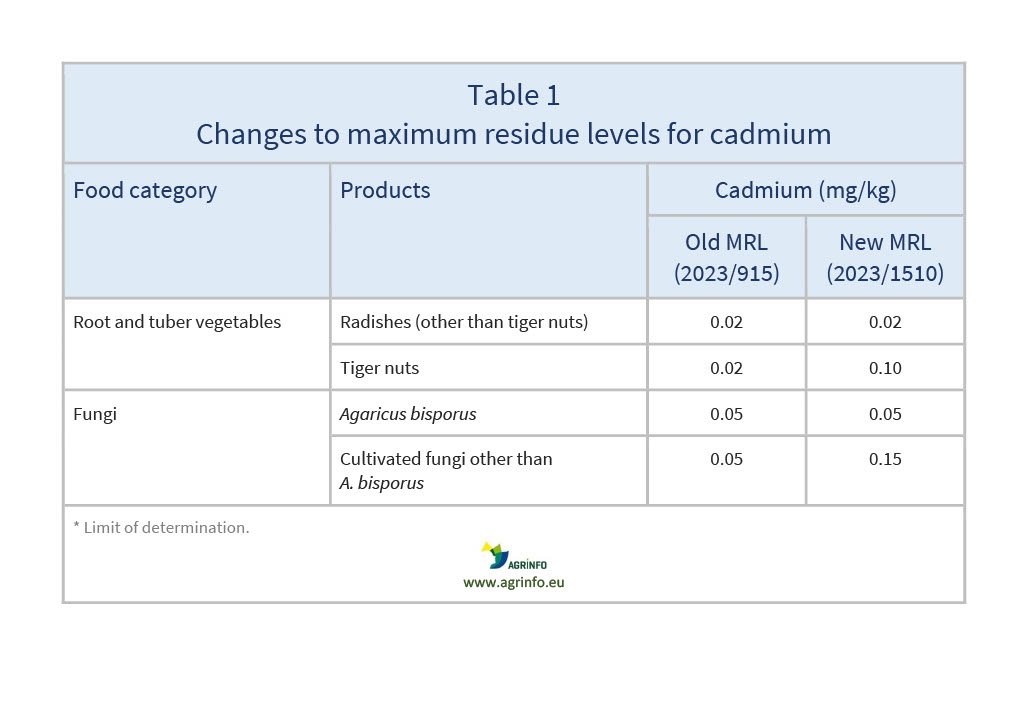Maximum levels of cadmium in certain foods
- Contaminants
Summary
The EU has increased the maximum levels for cadmium in tiger nuts and certain cultivated fungi to avoid disproportionate non-compliance rates, taking into account the "as low as reasonably achievable" (ALARA) principle.
EU increases maximum levels for cadmium in tiger nuts and certain cultivated fungi
Commission Regulation (EU) 2023/1510 of 20 July 2023 amending Regulation (EU) 2023/915 as regards maximum levels of cadmium in tiger nuts and certain cultivated fungi
Update
The EU has increased the maximum levels for cadmium in tiger nuts and certain cultivated fungi to avoid disproportionate non-compliance rates, taking into account the "as low as reasonably achievable" (ALARA) principle.
Impacted Products
Fungi, tiger nuts
What is changing?
The EU has raised the maximum levels of cadmium for tiger nuts and cultivated fungi other than Agaricus bisporus. The changes are highlighted in Table 1.
Why?
Tiger nuts contain higher concentrations of cadmium than other radishes, and cultivated fungi other than Agaricus bisporus contain concentrations of cadmium higher than those present in A. bisporus. As contaminant levels are set following the “ALARA” principle, the maximum levels have been adjusted to reflect these higher concentrations.
Timeline
Date of effect: 10 August 2023.
Recommended Actions
Suppliers of these products should regularly monitor the presence of cadmium. Information on recommended methods for sampling and analysis of the levels of cadmium in foodstuffs can be found in Regulation 333/2007.
Background
The maximum level for cadmium in radishes was lowered from 0.10 to 0.020 mg/kg by Regulation (EU) 2021/1323, and was also applied to tiger nuts. More recent occurrence data show that tiger nuts contain higher concentrations of cadmium than radishes. However, in view of the low consumption volume of tiger nuts, their contribution to consumer exposure to cadmium is limited.
Regulation (EU) 2021/1323 also lowered the maximum levels for cultivated fungi from 0.20 to 0.050 mg/kg for Agaricus bisporus, the most consumed species of this group. The maximum levels for Lentinula edodes and Pleurotus ostreatus were lowered from 0.20 to 0.15 mg/kg. More recent occurrence data show that some species of cultivated fungi contain higher cadmium concentrations than A. bisporus.
Agaricus bisporus, L. edodes, and P. ostreatus are the main fungi consumed in the EU. Other cultivated fungi are less consumed and therefore contribute less to consumer exposure to cadmium.
Resources
Commission Regulation (EC) No 333/2007 laying down the methods of sampling and analysis for the control of the levels of trace elements and processing contaminants in foodstuffs
Sources
Disclaimer: Under no circumstances shall COLEAD be liable for any loss, damage, liability or expense incurred or suffered that is claimed to have resulted from the use of information available on this website or any link to external sites. The use of the website is at the user’s sole risk and responsibility. This information platform was created and maintained with the financial support of the European Union. Its contents do not, however, reflect the views of the European Union.
EU increases maximum levels for cadmium in tiger nuts and certain cultivated fungi
Commission Regulation (EU) 2023/1510 of 20 July 2023 amending Regulation (EU) 2023/915 as regards maximum levels of cadmium in tiger nuts and certain cultivated fungi
What is changing and why?
The EU has raised the maximum levels for cadmium in tiger nuts and cultivated fungi other than Agaricus bisporus, taking into account the "As Low As Reasonably Achievable (ALARA)" principle. They contain higher concentrations of cadmium than similar products, but in view of their low consumption volume, these products do not contribute much to consumer exposure to cadmium.
Actions
Suppliers of these products should regularly monitor the presence of cadmium.
Timeline
Date of effect: 10 August 2023.
Tables & Figures
Disclaimer: Under no circumstances shall COLEAD be liable for any loss, damage, liability or expense incurred or suffered that is claimed to have resulted from the use of information available on this website or any link to external sites. The use of the website is at the user’s sole risk and responsibility. This information platform was created and maintained with the financial support of the European Union. Its contents do not, however, reflect the views of the European Union.

